Introduction to Astronomy
Normal Galaxies
Galaxies, or do you feel small yet?
Galaxies are basically big clusters of dust, gas, and stars. Even though the dust and gas occupy more space in a galaxy, the stars contribute far more to the mass.
There are 3.5 types of galaxies that we observe:
1) Spirals: Spirals consist of a bulge, a disk (with arms), and a halo. The bulge and the halo are both composed of reddish, older stars, but the disk and the arms are composed of bluish, younger stars. Without knowing anything else, you might think that this means that there is a lot more dust and gas in the disk than in the bulge or the halo, and you'd be right. Why? Because star formation occurs in gassy, dusty places!
The stars in the disk orbit the center of the galaxy in an ordered fashion. All of the stars travel around the bulge in the same "sense" (clockwise, or counter-clockwise). The stars in the halo and the bulge, however, travel in disordered orbits. These stars can orbit the center in either sense, or with any inclination to the disk. The whole thing is analogous to our solar system, which has a disordered massive center (the Sun), an ordered disk (the ecliptic), and a disordered outer cloud (the Oort Cloud). This means that the same physical principles are probably operating in galaxies as in our solar system! How about that!
Spirals are subdivided into classes a, b, and c. These classes roughly indicate the size of the bulge relative to the galaxy. A type Sa galaxy (Spiral a) has a large bulge, and tightly wound arms. A type Sc galaxy (Spiral c) has a small bulge, and very prominent arms.
1/2) Barred Spiral:
A barred spiral is very much like a spiral, except that the bulge is elongated, forming a bar across the center. Some people group barred spirals and spirals together in the same group. The barred spirals are also subdivided into three classes, SBa, SBb, and SBc. Once again, these sub-classes indicate the relative size of the bulge.
2) Ellipticals: Elliptical galaxies have no arms, no disk. They are just big blobs of reddish, older stars. These are sub-classed as E0...E3...E7. E0 are the roundest type, whereas E7 are the most elliptical. This subclassification is much less arbitrary than the subclassification of spirals, because you actually measure the axes to determine the subclass. However, projection effects (which side of the galaxy you are looking at---the short end, or the long side) can be important. Think of ellipticals like footballs. If you look at the end of a football, it looks round, but if you look at it from the side, it is elongated.
Ellipticals can also be sorted by size. Giant ellipticals are a few million mega-parsecs across!!!!! Recall how much trouble we had just talking about parsecs being large... These galaxies are a million, million parsecs across---WOW! Giant ellipticals contain trillions of stars, or a million, million stars. Dwarf ellipticals, on the other hand, are "only" about a thousand parsecs across, and contain "only" millions of stars. There are many more dwarfs than giants, but the giants are so large that they actually contain most of the mass that's found in elliptical galaxies.
Ellipticals contain very little gas and dust (as you'd expect where there are no young stars).
3) Irregulars: Irregular galaxies are all the galaxies that don't fit in the other categories. In general, they are thought to be the result of collisions between galaxies. They contain a lot of dust and gas, and consequently are full of young stars. There is no regular structure.
Galaxy Evolution: At one point, we thought that perhaps spirals evolved into ellipticals, or ellipticals into spirals, but nowadays, we freely admit that we don't understand galactic evolution. What changed? Well, for one thing, new pictures of a time when the galaxy was very young (only 1-2 billion years old), show that the proportion of spirals to ellipticals is the same as it is now. If evolution were happening, we would expect to see more ellipticals now, and more spirals then, or vice-versa. (This assumes that no galaxies are being born. A good assumption, since we have yet to see any evidence of galaxy formation regions!) A good analogy for this is the baby boom generation. There were more people "formed" at that time than at any other, so now the American population as a whole is aging. If the baby boomers had not had children, then we would expect to see nothing but elderly people in America in 10-20 years. So. If we don't make any new galaxies, we expect to see mostly old ones. But the proportion of galaxies of each type is about the same now as then, so spirals don't evolve into ellipticals, and ellipticals don't evolve into spirals. Galaxy evolution should take place on even longer time scales than stars, however, so it may be that the whole process is just too slow for us to understand it yet!
Galaxy distribution:
Most galaxies 'cluster', or come in groups. The three closest groups show the three different 'types' of clusters.
- THE LOCAL GROUP: This is the group which contains the Milky Way. It has approximately 35 galaxies, possibly many more small, faint ones. New members of the group are discovered every few years, either along the galactic disk (so they were hard to see through the dust and gas), or just small, faint ones. The Milky Way and Andromeda dominate the Local Group, having about 10 times as much luminous matter as all the other (33+) galaxies combined. They are approaching each other at about 300 km/s (which is VERY FAST, about 675,000 miles/hour). But, the luminous mass is only a small fraction of the mass in the Local Group. There is far more dark matter in the Local Group than luminous matter. We know this, because given the velocities of galaxies in the Group, it should have flown apart billions of years ago.
- THE VIRGO CLUSTER: is about 20 Mpc away, and contains more than 1,000 galaxies. It is moving away from the Local Group at about 1000 km/s, which is 200 km/s more slowly than it SHOULD move away from the Local Group. The two clusters interact slightly via gravity, and locally slow each other down from being carried out with the expansion of the Universe. In the picture below, the fuzzy blobs are galaxies in Virgo, and the point-like dots are foreground stars in our own galaxy.
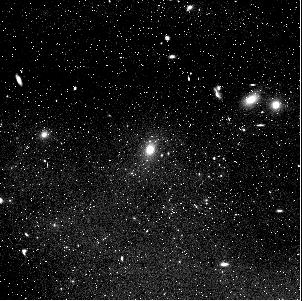
- THE COMA CLUSTER: has an extremely large number of bright galaxies (1000s of 'em). If we lived in the Coma cluster, we'd see galaxies all over the sky! Hundreds of them, some brighter than Mars, and all big enough that you could make out their shapes. Would that not be the coolest thing you could imagine?! In this image of the core of the Coma cluster, nearly all the objects you see are galaxies in Coma. A few of the smallest dots, and the 'spiky' objects are foreground stars in our own galaxy.
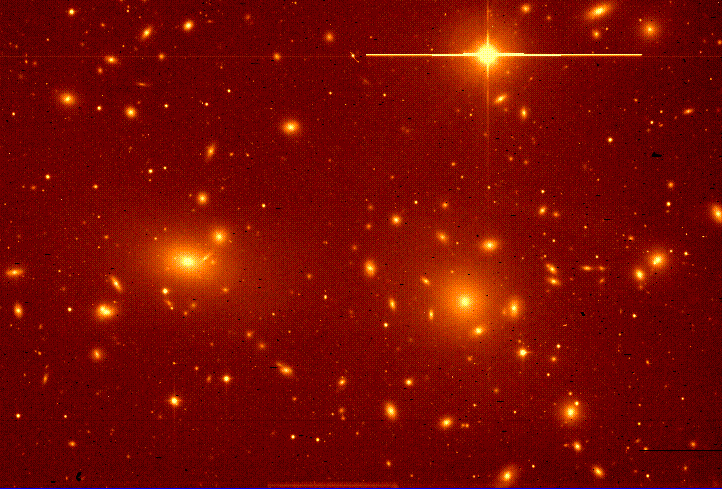
Not only do galaxies cluster, but clusters cluster as well, forming structures known as walls and voids. The voids are huge empty places, many millions of parsecs in diameter, with very few clusters in them, and the walls are long structures where lots of clusters can be found. Here's a picture of a MODEL of this large scale structure, run on a supercomputer (From the National Center for Supercomputing Applications :
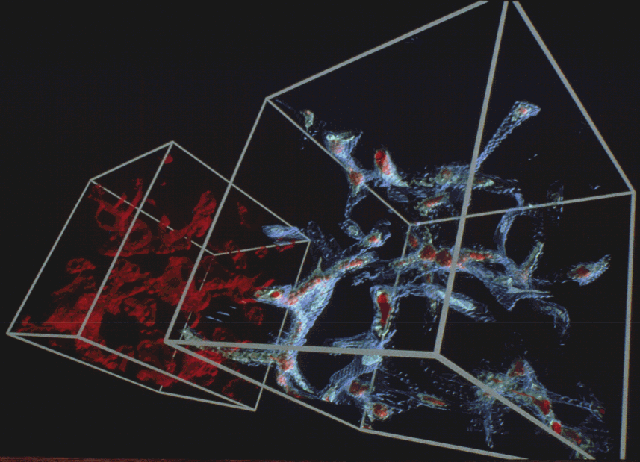 And here are the observations that these models hope to reproduce:
And here are the observations that these models hope to reproduce:
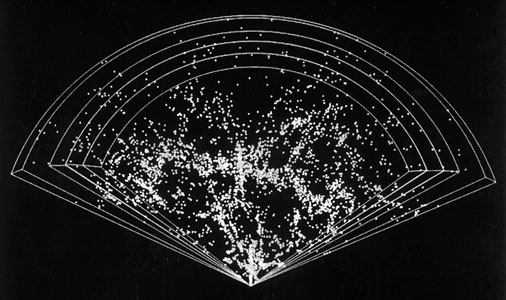 Cluster Formation
Cluster Formation
While we are not sure how clusters form, there are three basic ideas that have been put forth. One of them has fallen by the wayside, because it has serious problems, and as yet, there is no definitive evidence to allow us to determine which of the others might be correct.
- 'Zeldovich Pancakes': This is my favorite, just because the name is so cool. Unfortunately, it's also the one that doesn't work! So much for aesthetics... The idea here is that galaxy clusters form in essentially the same way that the solar system formed---a big cloud of gas collapses to form a proto-cluster, which then fragments to form individual galaxies which further collapse to form stars, etc. This is a 'top-down' model, where the largest structures form FIRST, and then each smaller structure forms after that.
But, this idea has serious flaws.
- The time for this collapse to happen is longer than the entire age of the Universe! oops.
- Small clusters like the Local Group can not be explained.
- The few small isolated galaxies that we observe in voids can not be explained.
- 'Hierarchical Model': in this model, galaxies form out of small(ish) clouds of gas, and then collect into clusters. This model has a hard time forming walls and voids, and also small clusters. Perhaps, if the models are tweaked enough, we could make it work.
- 'Explosion Model': Huge explosions at the time of the Big Bang may have swept out large voids, and piled material into walls. This model forms walls and voids, and it's not hard to imagine that isolated galaxies might get left behind, or small clusters like the Local Group. BUT! We have no way to explain such explosions, which must be EXTREMELY energetic, if they are to push all that mass around...
You now have a pretty good idea of what the Universe looks like. We've taken an entire census of the Universe, grouping stars and planets into stellar systems, and stars into galaxies, and galaxies into clusters and clusters into superclusters and superclusters into walls and voids, and now you know everything you need to know to start asking questions about how the Universe formed, how it is curved, how old it is, and so on. All of these questions about the Universe as a whole fall into the realm of 'Cosmology'. And that's where we are going next.
Cosmology
Several times now, I've mentioned that the Universe is expanding. We know this from Hubble's Law. Hubble was the guy who first noticed that the farther away a galaxy is, the faster it's moving away from us. This means that the Universe must be expanding (Recall the 'balloon lab'.).
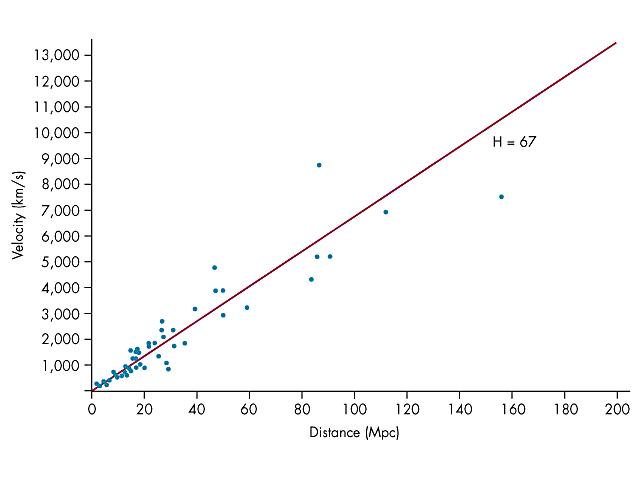 If we assume that the Universe has always been expanding at the same rate, we can use the slope of this line to find the age. How? Well. First imagine that you look out the window, and you see your roommate running away from your dorm at 6 miles an hour (slow runner, no?), and because you are using binoculars, you can still see her even though she's 12 miles away. You pause a moment, and realize that this means she left two hours ago. So
equation 1: t=d/v
But Hubble's Law says that
equation 2: v=Hd
Which can be rearranged to give
equation 3: d/v=1/H
compare equation 3 with equation 1. Combining the two states that
t=1/H
Thus, the age of the Universe (assuming constant expansion) can be derived from Hubble's constant, if you are careful about the units. Using the various values of Hubble's constant, the age of the Universe is between about 10 and 20 billion years.
If we assume that the Universe has always been expanding at the same rate, we can use the slope of this line to find the age. How? Well. First imagine that you look out the window, and you see your roommate running away from your dorm at 6 miles an hour (slow runner, no?), and because you are using binoculars, you can still see her even though she's 12 miles away. You pause a moment, and realize that this means she left two hours ago. So
equation 1: t=d/v
But Hubble's Law says that
equation 2: v=Hd
Which can be rearranged to give
equation 3: d/v=1/H
compare equation 3 with equation 1. Combining the two states that
t=1/H
Thus, the age of the Universe (assuming constant expansion) can be derived from Hubble's constant, if you are careful about the units. Using the various values of Hubble's constant, the age of the Universe is between about 10 and 20 billion years.




 And here are the observations that these models hope to reproduce:
And here are the observations that these models hope to reproduce:
 Cluster Formation
Cluster Formation
 If we assume that the Universe has always been expanding at the same rate, we can use the slope of this line to find the age. How? Well. First imagine that you look out the window, and you see your roommate running away from your dorm at 6 miles an hour (slow runner, no?), and because you are using binoculars, you can still see her even though she's 12 miles away. You pause a moment, and realize that this means she left two hours ago. So
equation 1: t=d/v
But Hubble's Law says that
equation 2: v=Hd
Which can be rearranged to give
equation 3: d/v=1/H
compare equation 3 with equation 1. Combining the two states that
t=1/H
Thus, the age of the Universe (assuming constant expansion) can be derived from Hubble's constant, if you are careful about the units. Using the various values of Hubble's constant, the age of the Universe is between about 10 and 20 billion years.
If we assume that the Universe has always been expanding at the same rate, we can use the slope of this line to find the age. How? Well. First imagine that you look out the window, and you see your roommate running away from your dorm at 6 miles an hour (slow runner, no?), and because you are using binoculars, you can still see her even though she's 12 miles away. You pause a moment, and realize that this means she left two hours ago. So
equation 1: t=d/v
But Hubble's Law says that
equation 2: v=Hd
Which can be rearranged to give
equation 3: d/v=1/H
compare equation 3 with equation 1. Combining the two states that
t=1/H
Thus, the age of the Universe (assuming constant expansion) can be derived from Hubble's constant, if you are careful about the units. Using the various values of Hubble's constant, the age of the Universe is between about 10 and 20 billion years.